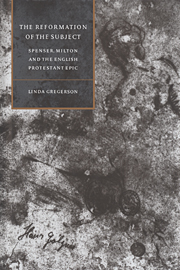Book contents
- Frontmatter
- Contents
- Acknowledgments
- Introduction
- 1 Emerging likeness: Spenser's mirror sequence of love
- 2 The closed image
- 3 Narcissus interrupted: specularity and the subject of the Tudor state
- 4 The mirror of romance
- 5 Fault lines: Milton's mirror of desire
- 6 Words made visible: the embodied rhetoric of Satan, Sin, and Death
- 7 Divine similitude: language in exile
- List of works cited
- Index
6 - Words made visible: the embodied rhetoric of Satan, Sin, and Death
Published online by Cambridge University Press: 08 October 2009
- Frontmatter
- Contents
- Acknowledgments
- Introduction
- 1 Emerging likeness: Spenser's mirror sequence of love
- 2 The closed image
- 3 Narcissus interrupted: specularity and the subject of the Tudor state
- 4 The mirror of romance
- 5 Fault lines: Milton's mirror of desire
- 6 Words made visible: the embodied rhetoric of Satan, Sin, and Death
- 7 Divine similitude: language in exile
- List of works cited
- Index
Summary
A labyrinth
They talk of plain, simple, literal, ingenious, cordial, real and I know not what; but the plain truth is, there is nothing plain nor true amongst men; but the whole life of man is a Tropical Figurative Converse, and a continual Rhetorication.
(Samuel Shaw, Words Made Visible [1679])It will be the business of this chapter to argue that, just as the parable of Malbecco functions as an explicating countertype to the subject construction proposed in Spenser's tale of Britomart, so the parable of Satan, Sin, and Death functions as an explicating countertype to the subject construction proposed, however problematically, in Milton's tale of Eve and Adam. Framed thus, the parallel is scarcely surprising. Unsurprising also will be the fact that I intend to focus upon the mechanisms of Satanic rhetoric, a topic common in the secondary literature on Paradise Lost. My interest, however, is not so much in the rhetoric practiced by the character of Satan in Milton's poem – his manipulative strategies, his puns, his specious logic are all familiar by now – as in the rhetoric embodied by that character and by the anomalous allegorical “family” he produces at the very heart of epic narrative. In Satan, Milton does not merely exemplify false rhetoric; he professes to have traced its etiology.
- Type
- Chapter
- Information
- The Reformation of the SubjectSpenser, Milton, and the English Protestant Epic, pp. 198 - 230Publisher: Cambridge University PressPrint publication year: 1995



